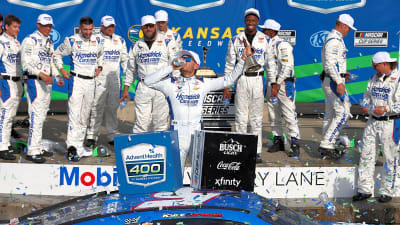
Forty years after the debut of 'The Winston,' has NASCAR's All-Star Race run its course?
It's been nearly 40 years since the inaugural NASCAR All-Star Race, then dubbed 'The Winston,' was held at the Charlotte Motor Speedway.
On May 25, 1985, Darrell Waltrip won the 70-lap, 105-mile event that was the first iteration of a race that would soon become a staple of the NASCAR calendar.
From that point on, "The Winston" was always must-see television. An initial pot of $200K to the winner meant the gloves were off.
Whether it was Dale Earnhardt's "Pass in the Grass" against Bill Elliott in 1987, Rusty Wallace spinning Waltrip in 1989 or Davey Allison crashing and winning under the lights in 1992, NASCAR's All-Star Race was a major hit with fans. It was a race that brought out both the best and the worst in the drivers they loved — Waltrip famously told the media he hoped Wallace would choke on the prize money after their incident in 1989.
Four decades after the first All-Star Race, however, the sentiment surrounding the event has changed. The race's location of North Wilkesboro Speedway, a track once left for dead in the mountains of North Carolina, is currently the All-Star Race's biggest attraction.
NASCAR has tried a slew of different formats over the four-decade history of the All-Star Race and even moved the event from Charlotte to Bristol and from Bristol to Texas. Fan votes, segmented races (in an era before stage racing) and pit crew challenges are just a few of the items NASCAR has utilized in an effort to keep the All-Star Race entertaining.
While it's still a race that proves important to drivers — Kyle Larson said that given the choice between winning the pole for the Indy 500 or racing in the All-Star Race, he'd choose the All-Star Race — it's clearly lost its luster.
A prize of only $1M for the race winner in 2025 doesn't do much in terms of promoting the race for fans who want to see drivers lay it all on the line for a major cash prize. When NASCAR proposed an outlaw-style All-Star Race where teams could bring heavily modified cars to the track, 23XI Racing co-owner Denny Hamlin said that teams would essentially be building a $2M car for a chance to only win $1M. That format for the race could be exciting for fans, but if it's not profitable for teams, it likely won't ever happen.
This year's All-Star format consists of a 250-lap feature around North Wilkesboro and a competition break around Lap 100 and includes the potential for a "promoter's caution" that could fly at any time before Lap 220.
Introducing new gimmicks isn't a bad thing in an exhibition race, but it's another complicated wrinkle in a race that has been through a myriad of changes over the years. In the race's heyday in the 1980s and early 1990s, the only gimmicks present in the race were segments, which today are present in every NASCAR race in the top-three series.
When what were out-of-the-ordinary circumstances meant to be fresh and flashy — segmented races, scheduled cautions, etc — in exhibition races are introduced into every race, exhibition races that showcase them, such as the All-Star Race, no longer feel special.
Is it fair to say that NASCAR's All-Star Race has run its course and should be taken off the schedule? Probably not. But increasing the winner's payout and keeping the format relatively simple are easy fixes that could be a step in the right direction if NASCAR wants to return the race to its former glory.
More must-reads:
- NASCAR power rankings: Kyle Larson's dominant day sees him retain No. 1 spot
- Why Kyle Larson may only be getting started after record-breaking Kansas win
- The 'NASCAR Cup Series winners' quiz
Customize Your Newsletter
 +
+
Get the latest news and rumors, customized to your favorite sports and teams. Emailed daily. Always free!







